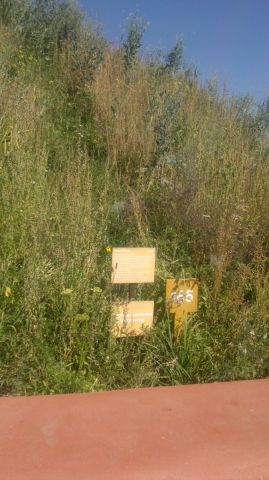Rubbish at dOCUMENTA (13)
There was plenty of rubbish at dOCUMENTA (13). I visited 18/08/12-21/08/12 which turned out to be a ~40°C heatwave weekend of the quinquennial contemporary art festival in Kassel.
There’s a big ecological and economical sustainability theme throughout documenta as works question our impact on the earth and its finite resources and these are distributed.
Billboards around Kassel ask ENERGY ≠ ART? / ENERGIE ≠ KUNST?
Song Dong’s Doing Nothing Garden (2007-2012) in front of the Orangerie in the park is “nothing more than an accumulation and preservation of waste.” A 6m high mound of rubble and biological waste left to overgrow with weeds stands like a monument in the open space in clear view.
AND …AND …AND artist run initiative have produced a Non-Capitalist Herbal (Tea) Garden outside the Ottoneum, a Solidarity Economy Food Kiosk in Karlsaue Park and a lab at the Nachrichtenmeisterei.
In documenta-halle, Kristina Buch displays empty chrysalises from over 100 days, apparently adding to the collection on a regular basis. The focal point of her piece The Lover (2012) is actually the open-air live butterfly installation outside.
Gareth Moore’s inhabitance on the edge of Karlsaue Park is described as “an open-ended pilgrimmage to the wonderous world of disregarded things.” A primitive hunter-gather methodology creates a large scale installation where visitors check in their mobile phone and cameras in exchange for a conker on a wristband to navigate the pathways lined with tin lids on string. Using found materials since 2010, Moore has built an environment where he has lived in situ from the detritus others have left behind.
In the Friedricianum, Mariana Castillo Deball – Uncomfortable Objects (2012) is a sloping surface of manmade and natural objects and materials melded together in a steel frame
Tejal Shah’s Landfill video in southern wing of the Hauptbahnhof is mesmerising performance of costumed dances in a landfill.
Fiona Hall’s Fall Prey (2011) addresses the notion of value of objects, materials and symbols through beautifully crafted animals displayed like trophies in a museumesque installation in one of the many huts in Karlsaue Park. The animals are made from shredded military camouflage and consumer items such as bottle caps and catergorised as “endangered,” “critically endangered” or “extinct in the wild.”
So much rubbish, so little time.
Outside AND ..AND ..AND’s lab in the Nachrichtenmeisterei I find half an abandoned press pack which has some leaflets, the Was/Wann book of events that’s on sale for €3 in the dOCUMENTA cabin shops and a little book that I couldn’t find in the bookshops entitled dOCUMENTA (13): A Sustainable Exhibition. Ecologically Designed & Implemented. The cover is a recycled card which doesn’t lend itself very well to the bright green print explaining how Duales System Holding have made the “eco-compatible” pavilions in the park, designed to “keep recyclable materials in a closed circuit economy” and “eliminate waste of raw materials.” Other than the minimal blurb, the book is a picture postcard compilation of the “eco-compatible” pavilions. How ironic this should be left discarded on a bench.













